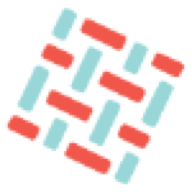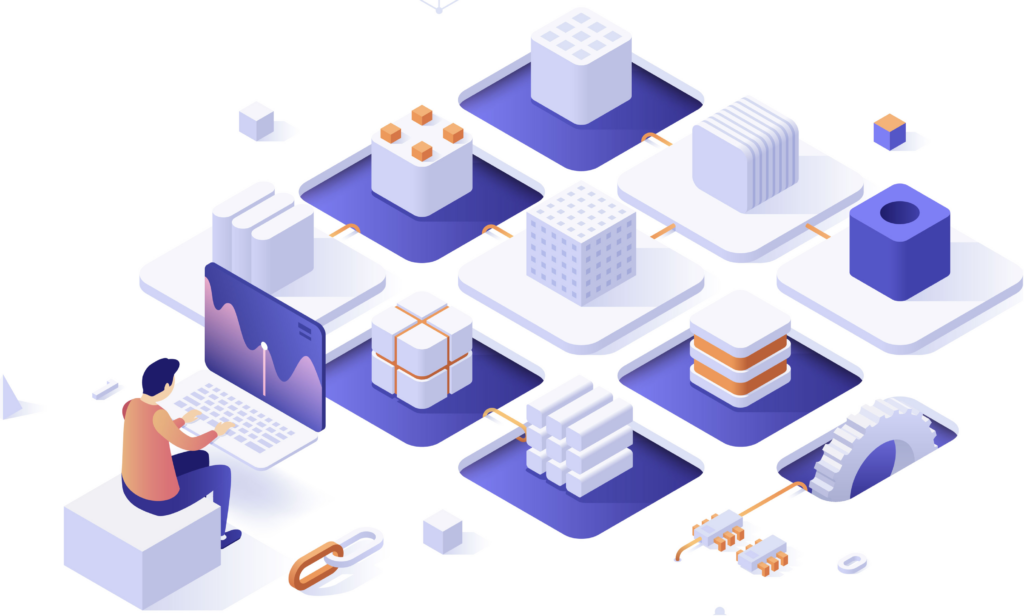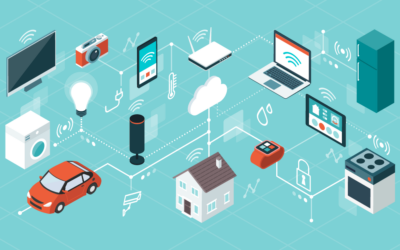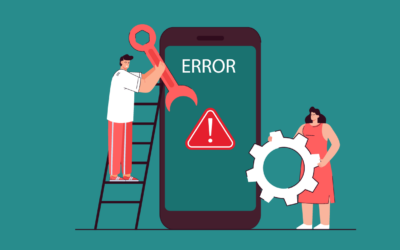Design and build a business blockchain network to create outcomesacross an ecosystem of collaborators with end-to-end data visibilityand workflow automation for sustaining business growth.
Introduction to Blockchain Networks
This blog post is an overview of the topic written to help the general business reader become familiar with the basic terms and concepts in order to begin a conversation about blockchain networks and app development.
What is Blockchain?
Blockchain is a secure system architecture that runs transactions and distributes data across networks (nodes) that are replicated and synchronized in a ledger and can be verified by its partners. Blockchain is a distributed ledger, or new distributed database (shared in a network), that provides a cryptographic mechanism to encode information (tamper-proof).
Blockchain is a foundational technology that provides cross-organizational trust and transparency for business transactions. In addition, it enables immutable transactions, meaning they cannot be changed once they are recorded on the chain, removing middlemen and saving time and costs.
Blockchain Networks
Distributed—Secured—Transparent—Immutable
- Records transactions in digital ledger
- Stores information across the network of computers
- Operates on peer-to-peer partner network without intermediaries
- Transactions are authenticated by cryptography and digital signatures
Blockchain Distributed Ledgers
A blockchain distributed ledger is an encrypted system that records and tracks transactions in blocks. These are replicated and synchronized among the participants (nodes) across the network. They validate the chain of records (blocks), which cannot be changed (i.e., they are locked). Blockchain distributed ledgers are a trusted source of information for transaction data.
Blockchain Networks Enable Business Use Cases
Distributed Network Architecture
Blockchain architectures have enabled cryptocurrency and have provided a starting point to understanding the technologies to develop other use cases. Businesses must understand blockchain capabilities and how to integrate them into their architectures, systems, and products.
Product architects are helping to design products that integrate with existing cloud technologies, helping companies develop workflows to interact with data generated in the blockchain through smart contracts (code).
Types of Blockchain Networks
There are public and private blockchain networks that differ in regard to who can view the data (ledger). Public networks, such as cryptocurrency blockchains, are open to the public (permissionless). On the other hand, private networks require encryption keys, permissions (permissioned networks), and knowledge about their participants (KYC).
Businesses can choose to create private blockchain networks for doing transactions and share the ledger only with the community of partners (unified ledgers). Also, networks follow verification rules, or consensus protocols, to validate transactions or blocks and maintain the ledgers in sync.
Consensus Algorithms
- Proof of Work (PoW)
- Proof of Stake (PoS)
- Proof of Elapsed Time (PoET)
- Blockchain networks create transparency and trust by using cryptographic hashes (hashing), digital signatures, and rules on how to verify the data.
Smart Contracts and Decentralized Applications (DApps)
A product or service records data as a smart contract using DApps, with logic embedded in a blockchain private network where several players can participate in building a solution. For example, when a client buys a car, the insurance providers, loan applications, and maintenance contracts all have to work together with the same customer information (dataset), apply a process, and integrate it into the blockchain.
The blockchain network detects changes in the data model, runs it against the data stored on the blockchain database, accepts or rejects the modification according to the rules, and then sends notifications. These changes are visible data transactions seen through a created mobile app.
A company can ask to join a network, and the network members have to accept (or deny) the request. Then, after evaluating the terms and conditions of the smart contract, the company may decide to join and participate in the network and try to get clients by matching the contract logic and abiding by the established business rules.
Businesses must build decentralized applications (DApps) to interact with blockchain systems. DApps call functions, pull information from smart contracts (code), and run workflows in other DApps. In addition, products and services use information from the blockchain, where network players can use and select participants to verify transactions (selective endorsement).
Blockchain is the decentralized platform where the transactions will occur using a shared ledger and decentralized apps, connecting systems (ERP, CRM, cloud, etc.) and databases to provide a synchronized source of data for all parties with capabilities to process smart functions and keep data flowing transparently.
To access private networks, third-party providers or regulators can get authorization to access and visualize the transaction history in the blockchain and verify the authenticity of the data. But the actual blockchain partners have digital keys that give them access to the sensitive records of their customers’ transactions that are not accessible to others.
Businesses can also create a mobile app for viewing data.
Click the link to learn more about how an app is created.

Hyperledger Blockchain Platforms
Hyperledger blockchain is an open-source blockchain project that is accelerating blockchain adoption for enterprises. This is a robust modular platform that provides an industry-standard permissioned network with feature-rich infrastructure to build solutions for private transactions, reducing risks, and improving time-to-market. The Linux Foundation hosts it.
Hyperledger promotes a collaborative environment in an interoperable platform that supports transactions with various distributed ledgers with special features and needs across industries for use cases requiring different consensus algorithms, confirmation times, confidentiality requirements, etc.
Hyperledger is a modular system with components and combinations that can be used, reused, or changed as a project evolves, with APIs that support interoperability with other systems and apps, enabling integration with its infrastructure.
Several Hyperledger frameworks provide various features and functions to build blockchain solutions. Since this topic is not the focus of this article, however, we are mentioning only two of the many frameworks that Hyperledger offers: Sawtooth and Fabric.

Hyperledger Sawtooth
This is a technology that allows collaboration using a single node that can be installed on the cloud or on-premises in order to develop decentralized ledgers and secured smart contracts. Sawtooth provides unchained governance allowing enterprises to manage all aspects of the network. Participants are able to set policies and configurations as well as integrate with existing internal databases, keeping them in sync with the Sawtooth network.
Furthermore, apps can be created on top of Sawtooth using SDK and REST APIs. The main Hyperledger technical innovations are dynamic consensus (change consensus algorithms), enablement of smart contract logic in any language, compatibility with Ethereum contracts for enterprise, faster block processing with parallel transaction executions, and separate permissioning for privacy.
Hyperledger Fabric is an extensible platform with a modular architecture for creating and running distributed ledger applications that can adapt to any industry with plug-and-play components. Fabric can work with containers to host smart contracts (chaincode), and it supports various consensus protocols for different use cases. Fabric can run apps written in general purpose languages, and it doesn’t rely on native cryptocurrency. Its notion of portable membership can be integrated with standard identity management. It also enables channels for creating separate ledgers to keep sensitive information private from other network members.

Hyperledger Fabric
Ethereum Platform
Cloud Platforms and Blockchain Networks
Cloud platforms allow businesses to create solutions on top of a Hyperledger platform. For example, Salesforce, Inc. offers the capability for customers to build trusted blockchain networks from its CRM platform. Salesforce extends its features with low-code tools that make blockchain data actionable in its platform services using apps or by connecting APIs to custom apps to engage customers not using its services.
Clients can create a blockchain app on top of its platform, hiding all the complexities of blockchain but allowing them to deploy the technology across a trusted network, connecting data sources and disparate systems. In addition, the platforms allow querying the blockchain, capturing activity, and exposing it to its workflow. It also gives access to partners and data synchronization services that integrate with its user interface (UI) and its data.
Blockchain Benefits for Businesses
- Optimize workflows around data across your value stream
- Reduce costs by streamlining processes with business partners
- Increase speed of execution through smart contracts
- Automate tasks
- Improve brand authenticity and develop better relationships with customers
- Create new revenue streams (monetization) with asset tokenization (NFTs)
- Lower costs by adding partners to the database instead of building integrations
- Develop a high level of trust due to immutability principles












